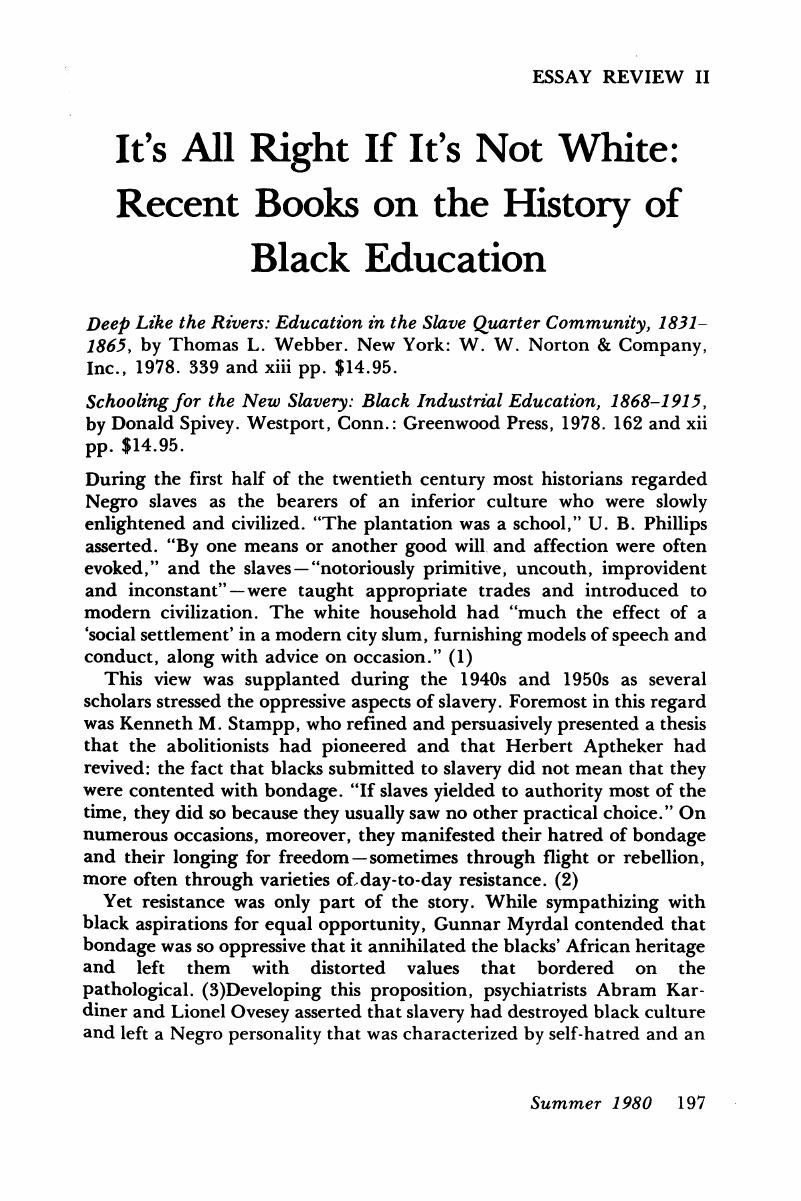Article contents
It's All Right If It's Not White: Recent Books on the History of Black Education
Published online by Cambridge University Press: 24 February 2017
Abstract

- Type
- Essay Review II
- Information
- Copyright
- Copyright © 1980 by History of Education Society
References
Notes
1 Phillips, Ulrich B., Life and Labor in the Old South (New York, 1929), pp. 198, 200, 211.Google Scholar
2 Stampp, Kenneth M., The Peculiar Institution (New York, 1956), p. 91 and passim ; Aptheker, Herbert, American Negro Slave Revolts (New York, 1943).Google Scholar
3 Myrdal, Gunnar, An American Dilemma (New York, 1944).Google Scholar
4 Kardiner, Abram and Ovesey, Lionel, The Mark of Oppression (New York, 1951).Google Scholar
5 Stampp, , The Peculiar Institution, pp. 340, 364.Google Scholar
6 Elkins, Stanley M., Slavery (Chicago, 1959).Google Scholar
7 Silberman, Charles E., Crisis in Black and White (New York, 1964), pp. 75, 77.Google Scholar
8 Lewis, Oscar, “The Culture of Poverty,” in Moynihan, Daniel P., ed., On Understanding Poverty (New York), p. 188.Google Scholar
9 Blassingame, John W., The Slave Community (New York, 1972); Genovese, Eugene D., Roll, Jordan, Roll (New York, 1974); Gutman, Hevert G., The Black Family in Slavery and Freedom, 1950–1925 (New York, 1976); Levine, Lawrence W., Black Culture and Black Consciousness (New York, 1977); Owens, Leslie Howard, This Species of Property (New York, 1976); Rawick, George P., From Sundown to Sunup (Westport, conn., 1972).Google Scholar
10 Genovese, , Roll, Jordan, Roll, pp. 658, 3; Genovese, , “Solidarity and Servitude,” Times Literary Supplement, Feburary 25, 1977, p. 199; Genovese, , “Toward a Psychology of Slavery,” in Gilmore, Al-Tony, ed., REvisiting Blassingame's “The Slave Community” (Westport, Conn., 1978), p. 29.Google Scholar
11 Gutman, , The Black Family, pp. 309–320 and passim .Google Scholar
12 Blassingame, John W., “Using the Testimony of Ex-Slaves: Approaches and Problems,” Journal of Southern History, 41 (November 1975), 473–493.CrossRefGoogle Scholar
13 Engerman, Stanley, “Reconsidering The Slave Community ,” in Gilmore, , ed., Revisting Blassingame, p. 105.Google Scholar
14 Wyatt-Brown, Bertram, “The New Consensus,” Commentary, 63 (January 1977), 76–78.Google Scholar
15 Blassingame, John W., “Redefining The Slave Community,” in Gilmore, ed., Revisiting Blassingame, pp. 151–154.Google Scholar
16 McPherson, James M., The Abolitionist Legacy (Princeton, N.Y., 1975), pp. 58, 59.Google Scholar
17 Ibid., pp. 53, 185.Google Scholar
18 Ibid., p. 66.Google Scholar
19 Ibid., p. 201.Google Scholar
20 Ibid., p. 176.Google Scholar
21 Spivey, , Schooling for the New Slavery, p. 51. Washington usually did not speak so directly. Although he did not endorse the idea that blacks should be trained only as hewers of wood and drawers of water, through carefully selected ambiguities in language and by deemphasizing civil and political rights Washington often managed to convey the impression that he accepted the Southern orthodoxy.Google Scholar
22 Meier, August, Negro Thought in America, 1880–1915 (Ann Arbor, Michigan, 1963), pp. 99, 101.Google Scholar
23 Du Bois, W. E. B., “Education,” Crisis, 10 (July 1915), 132; Bois, Du, “The Year in Colored Colleges,” Crisis, 4 (July 1912), 136.Google Scholar
24 Bois, Du, “Of the Training of Black Men,” Atlantic Monthly, 90 (September 1902), 294.Google Scholar
- 1
- Cited by


